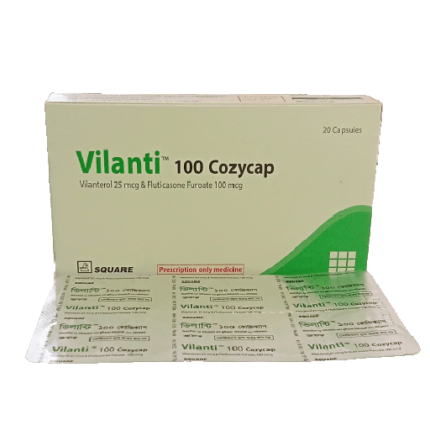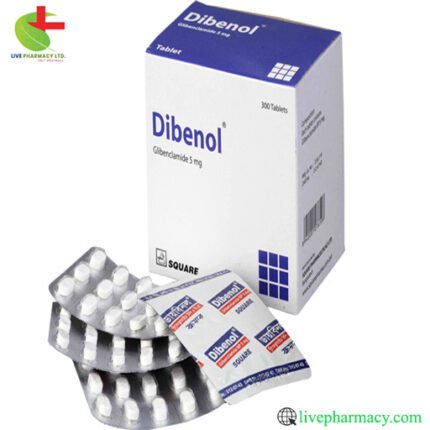Vilanti 200 Cozycap
300.00৳ Strip
- Experience an innovative inhalation capsule formulated for adults with chronic obstructive pulmonary disease (COPD) and asthma.
- Our capsule blends Vilanterol and Fluticasone Furoate to address airway obstruction and inflammation, providing effective relief.
- With convenient once-daily dosing, prioritize ease of use and adherence for patients.
- Meticulously consider potential interactions and precautions to ensure safety and well-being.
 Brand
Brand
|
Square Pharmaceuticals PLC |
|---|---|
 Generics
Generics
|
Vilanterol Trifenatate + Fluticasone Furoate |
Indications
This medication is recommended for:
- Long-term, once-daily maintenance therapy to manage airflow obstruction and minimize exacerbations in individuals diagnosed with chronic obstructive pulmonary disease (COPD).
- Once-daily treatment of asthma in adults aged 18 years and above.
Important Usage Note
This medication is not intended for immediate relief of acute bronchospasm.
Composition
- Inhalation Capsule 25/100: Each dry powder inhaler capsule contains Vilanterol 25 mcg (as Vilanterol Trifenatate INN) & Fluticasone Furoate INN 100 mcg.
- Inhalation Capsule 25/200: Each dry powder inhaler capsule contains Vilanterol 25 mcg (as Vilanterol Trifenatate INN) & Fluticasone Furoate INN 200 mcg.
Description
Vilanterol Trifenatate is a selective, long-acting beta-2 agonist utilized in treating asthma and other forms of diffuse airway obstruction. Fluticasone Furoate, on the other hand, is a corticosteroid primarily exhibiting glucocorticoid activity. Fluticasone Furoate is noted for its localized action on the lungs without significant systemic effects at typical doses.
Pharmacology
This medication combines Fluticasone Furoate and Vilanterol, each with distinct mechanisms of action. Beta 2-adrenoceptor agonists like Vilanterol stimulate intracellular adenyl cyclase, leading to relaxation of bronchial smooth muscle and inhibition of hypersensitivity mediator release. The precise mechanism through which Fluticasone Furoate affects COPD and asthma symptoms is not fully understood but is thought to involve its anti-inflammatory properties.
Dosage & Administration
- This inhalation capsule should not be ingested and is to be used only with the specified device.
- The capsule should be removed from its blister pack immediately before use.
- After inhalation, rinse the mouth with water without swallowing to minimize the risk of oropharyngeal candidiasis.
Route of administration: Oral inhalation.
- For COPD maintenance treatment: One inhalation of 25/100 mcg once daily.
- For asthma: One inhalation of either 25/100 mcg or 25/200 mcg once daily.
[Translation Note: “Follow the advice of a healthcare professional when using medication.”]
Interaction:
- Caution is advised when using strong cytochrome P450 3A4 inhibitors (e.g., ketoconazole) due to potential systemic corticosteroid and cardiovascular effects.
- Extreme caution is recommended when using monoamine oxidase inhibitors and tricyclic antidepressants, as they may potentiate Vilanterol’s effects on the vascular system.
- Beta-blockers should be used with caution to avoid blocking the bronchodilatory effects of beta-agonists, which could lead to severe bronchospasm.
- Diuretics should also be used cautiously, as non–potassium-sparing diuretics may exacerbate electrocardiographic changes and/or hypokalemia when used concurrently with beta-agonists.
Contraindications
- Avoid using this medication as primary treatment for status asthmaticus or acute episodes of COPD or asthma requiring intensive measures.
- Individuals with severe hypersensitivity to milk proteins or any ingredients should refrain from using this medication.
Side Effects
- For COPD: Common adverse reactions (≥3%) include nasopharyngitis, upper respiratory tract infection, headache, oral candidiasis, back pain, pneumonia, bronchitis, sinusitis, cough, oropharyngeal pain, arthralgia, hypertension, influenza, pharyngitis, and pyrexia.
- For asthma: Common adverse reactions (≥2%) include nasopharyngitis, oral candidiasis, headache, influenza, upper respiratory tract infection, bronchitis, sinusitis, oropharyngeal pain, dysphonia, and cough.
Pregnancy & Lactation
Limited data are available regarding the use of this medication in pregnant women and lactating mothers.
Precautions & Warnings
- Monotherapy with long-acting beta-2 agonists (LABAs) may increase the risk of serious asthma-related events.
- Avoid initiating treatment during acute exacerbations of COPD or asthma and refrain from using it for acute symptom relief.
- Do not combine with another medication containing a LABA to prevent the risk of overdose.
- Monitor for Candida albicans infection of the mouth and pharynx, especially after inhalation, and advise patients to rinse their mouths with water without swallowing.
- Monitor patients with COPD for signs and symptoms of pneumonia, as there is an increased risk associated with this medication.
- Use with caution in patients with existing infections or conditions such as tuberculosis, fungal, bacterial, viral, or parasitic infections, as well as ocular herpes simplex, which may worsen with this medication.
- Gradually taper patients off systemic corticosteroids when transitioning to this inhalation capsule to minimize the risk of impaired adrenal function.
- Discontinue this medication if paradoxical bronchospasm occurs and consider alternative therapy.
- Exercise caution in patients with cardiovascular disorders due to beta-adrenergic stimulation.
- Assess bone mineral density initially and periodically in patients using this medication long term.
- Long-term use of inhaled corticosteroids may lead to glaucoma and cataracts; consider referral to an ophthalmologist if ocular symptoms develop.
- Use with caution in patients with convulsive disorders, thyrotoxicosis, diabetes mellitus, and ketoacidosis, as well as in those at risk of hypokalemia or increased blood glucose levels.
Use in Special Populations
- This medication is not indicated for use in children and adolescents aged 17 years and younger; safety and efficacy in this population have not been established.
- In patients with hepatic impairment, monitor for systemic corticosteroid effects, as Fluticasone Furoate systemic exposure may increase in those with moderate or severe impairment.
Overdose Effects
Clinical trial data on overdose with this inhalation capsule are not available.
Therapeutic Class
Respiratory corticosteroids
Storage Conditions
Store in a cool, dry place away from direct sunlight and heat. Keep out of reach of children and avoid contact with eyes.













Reviews
There are no reviews yet.